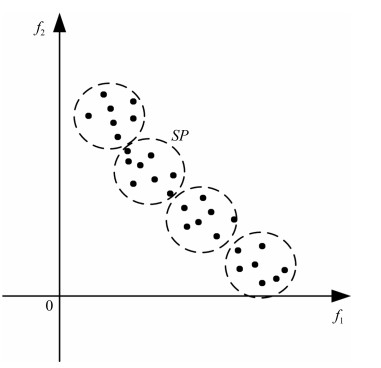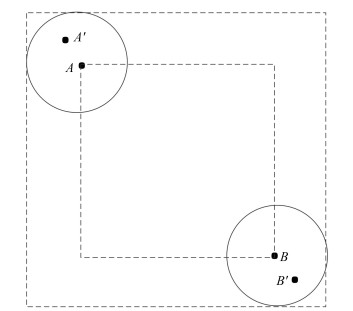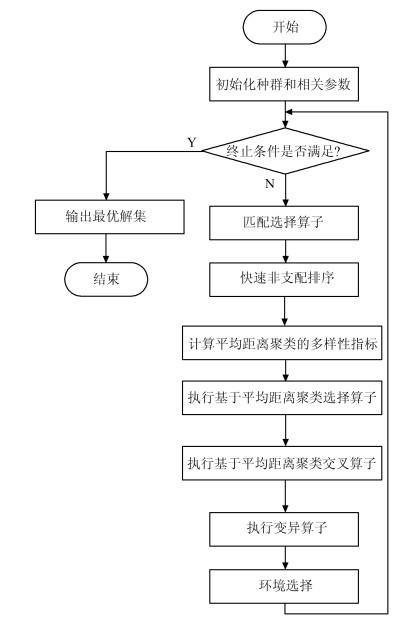-
摘要: 拥挤度距离是一种用于度量解集多样性的指标. 然而, 在许多情况下, 该指标无法有效区分多样性较优个体. 其原因为拥挤度距离主要利用每个位置的局部信息. 为解决该问题, 基于整个种群全局位置信息, 本文设计了基于平均距离聚类的多样性度量指标, 并进一步提出了基于平均距离聚类的NSGA-Ⅱ. 该算法利用平均距离将种群划分为若干个大致均匀分布的小种群, 然后分别在各小种群内执行选择、交叉和变异等操作. 实验结果表明, 本文所提算法可以有效地保持种群多样性.Abstract: Crowding distance is an index for measuring the diversity of solutions. However, in many cases, it may fail to identify individuals with better diversity. The reason is that crowding distance mainly takes advantage of the local information of each position. To tackle this issue, based on the global position information of entire population, this paper designs average-distance-clustering diversity index, and further proposes NSGA-Ⅱ with average distance clustering (ADCNSGA-Ⅱ). ADCNSGA-Ⅱ divides the entire population into several small populations using average distance, then the selection, crossover and mutation operators are performed in each small population. Simulation results show the proposed algorithm can maintain the diversify effectively.
-
Key words:
- Multi-objective optimization algorithms /
- NSGA-Ⅱ /
- crowding distance /
- diversity
1) 本文责任编委 张敏灵 -
表 1 参数$S$对算法ADCNSGA-Ⅱ性能影响
Table 1 Influence of parameter $S$ on ADCNSGA-Ⅱ
测试函数 指标 $S=1$ $S=2$ $S=3$ $S=4$ $S=5$ $S=6$ SCH mean$(GD)$ $ \bf{5.87\times 10^{-2}} $ $6.47\times 10^{-2}$ $6.68\times 10^{-2}$ $6.77\times 10^{-2}$ $6.67\times 10^{-2}$ $6.69\times 10^{-2}$ std$(GD)$ $8.14\times 10^{-3}$ $ \bf{3.84\times 10^{-3}}$ $5.03\times 10^{-3}$ $5.11\times 10^{-3}$ $5.28\times 10^{-3}$ $4.15\times 10^{-3}$ mean$(SP)$ $ \bf{9.87\times 10^{-3}}$ $1.18\times 10^{-2}$ $1.77\times 10^{-2}$ $1.89\times 10^{-2}$ $2.28\times 10^{-2}$ $1.77\times 10^{-2}$ std$(SP) $ $6.23\times 10^{-3}$ $ \bf{2.62\times 10^{-3}}$ $1.12\times 10^{-2}$ $1.07\times 10^{-2}$ $2.16\times 10^{-2}$ $1.01\times 10^{-2}$ ZDT1 mean$(GD) $ $ \bf{2.05\times 10^{-6}}$ $4.07\times 10^{-6}$ $4.71\times 10^{-5}$ $3.28\times 10^{-5}$ $7.25\times 10^{-5}$ $7.71\times 10^{-5}$ std$(GD)$ $ \bf{1.11\times 10^{-5}}$ $2.10\times 10^{-5}$ $8.90\times 10^{-5}$ $6.66\times 10^{-5}$ $1.32\times 10^{-4}$ $1.28\times 10^{-4}$ mean$(SP)$ $ \bf{4.48\times 10^{-3}}$ $5.34\times 10^{-3}$ $5.94\times 10^{-3}$ $6.48\times 10^{-3}$ $5.87\times 10^{-3}$ $5.42\times 10^{-3}$ std$(SP)$ $1.59\times 10^{-3}$ $1.31\times 10^{-3}$ $ \bf{1.20\times 10^{-3}}$ $1.92\times 10^{-3}$ $2.57\times 10^{-3}$ $1.78\times 10^{-3}$ ZDT2 mean$(GD)$ $ \bf{1.32\times 10^{-5}}$ $3.80\times 10^{-5}$ $5.17\times 10^{-5}$ $5.51\times 10^{-5}$ $8.31\times 10^{-5}$ $8.55\times 10^{-5}$ std$(GD)$ $ \bf{6.55\times 10^{-5}}$ $9.60\times 10^{-5}$ $9.26\times 10^{-5}$ $7.18\times 10^{-5}$ $9.89\times 10^{-5}$ $1.21\times 10^{-4}$ mean$(SP)$ $ \bf{4.47\times 10^{-3}}$ $5.40\times 10^{-3}$ $6.32\times 10^{-3}$ $6.91\times 10^{-3}$ $6.78\times 10^{-3}$ $6.79\times 10^{-3}$ std$(SP)$ $1.79\times 10^{-3}$ $ \bf{1.02\times 10^{-3}}$ $1.44\times 10^{-3}$ $2.60\times 10^{-3}$ $3.32\times 10^{-3}$ $2.46\times 10^{-3}$ ZDT3 mean$(GD)$ $ \bf{1.09\times 10^{-6}}$ $6.07\times 10^{-6}$ $2.48\times 10^{-5}$ $3.57\times 10^{-5}$ $1.38\times 10^{-5}$ $5.13\times 10^{-5}$ std$(GD)$ $ \bf{5.91\times 10^{-6}}$ $2.61\times 10^{-5}$ $5.56\times 10^{-5}$ $5.54\times 10^{-5}$ $2.20\times 10^{-5}$ $5.81\times 10^{-5}$ mean$(SP)$ $ \bf{4.93\times 10^{-3}}$ $6.20\times 10^{-3}$ $6.01\times 10^{-3}$ $7.84\times 10^{-3}$ $6.85\times 10^{-3}$ $8.04\times 10^{-3}$ std$(SP)$ $1.89\times 10^{-3}$ $ \bf{1.21\times 10^{-3}}$ $2.12\times 10^{-3}$ $3.61\times 10^{-3}$ $2.22\times 10^{-3}$ $2.91\times 10^{-3}$ ZDT4 mean$(GD)$ $1.51\times 10^{-5}$ $8.46\times 10^{-6}$ $2.03\times 10^{-5}$ $ \bf{4.54\times 10^{-6}}$ $2.67\times 10^{-5}$ $7.20\times 10^{-6}$ std$(GD)$ $4.49\times 10^{-5}$ $2.13\times 10^{-5}$ $4.46\times 10^{-5}$ $ \bf{1.25\times 10^{-5}}$ $6.31\times 10^{-5}$ $1.76\times 10^{-5}$ mean$(SP)$ $ \bf{3.29\times 10^{-3}}$ $5.21\times 10^{-3}$ $6.01\times 10^{-3}$ $5.98\times 10^{-3}$ $6.43\times 10^{-3}$ $6.43\times 10^{-3}$ std$(SP)$ $1.64\times 10^{-3}$ $ \bf{1.20\times 10^{-3}}$ $1.75\times 10^{-3}$ $1.65\times 10^{-3}$ $2.01\times 10^{-3}$ $3.32\times 10^{-3}$ ZDT6 mean$(GD)$ $ \bf{1.11\times 10^{-2}}$ $2.07\times 10^{-2}$ $2.07\times 10^{-2}$ $3.27\times 10^{-2}$ $9.92\times 10^{-3}$ $2.29\times 10^{-2}$ std$(GD)$ $ \bf{2.34\times 10^{-2}}$ $3.86\times 10^{-2}$ $4.77\times 10^{-2}$ $5.42\times 10^{-2}$ $3.61\times 10^{-2}$ $4.08\times 10^{-2}$ mean$(SP)$ $\bf{1.77\times 10^{-2}}$ $6.14\times 10^{-2}$ $5.52\times 10^{-2}$ $7.81\times 10^{-2}$ $ {1.09\times 10^{-2}}$ $4.55\times 10^{-2}$ std$(SP)$ $5.80\times 10^{-2}$ $1.64\times 10^{-1}$ $1.26\times 10^{-1}$ $1.18\times 10^{-1}$ $ \bf{3.05\times 10^{-2}}$ $1.14\times 10^{-1}$ 表 2 Friedman测试结果
Table 2 Comparison results of Friedman test
参数 秩均值 $S=1$ 1.92 $S=2$ 2.40 $S=3$ 3.67 $S=4$ 4.38 $S=5$ 4.23 $S=6$ 4.42 表 3 Wilcoxon检测测试结果
Table 3 Comparison results of Wilcoxon test
$S=1$对比 p值 $S=2$ 0.0765 $S=3$ 0.0018 $S=4$ 0.0003 $S=5$ 0.0258 $S=6$ 0.0003 表 4 实验性能均值和方差对比
Table 4 Means and variances of the performance metrics
测试函数 指标 PNIA SPEA2 NSGA-Ⅱ g-NSGA-Ⅱ ADCNSGA-Ⅱ SCH mean$(GD)$ $ \bf{3.81\times 10^{-2}} $ $4.41\times 10^{-2}$ $6.17\times 10^{-2}$ $4.43\times 10^{-2}$ $5.87\times 10^{-2}$ std$(GD)$ $ \bf{1.93\times 10^{-3}}$ $1.14\times 10^{-3}$ $2.96\times 10^{-3}$ $1.61\times 10^{-2}$ $8.14\times 10^{-3}$ mean$(SP)$ $ \bf{4.96\times 10^{-3}}$ $7.01\times 10^{-3}$ $1.75\times 10^{-2}$ $3.25\times 10^{-2}$ $9.87\times 10^{-3}$ std$(SP)$ $ \bf{3.66\times 10^{-3}}$ $1.61\times 10^{-3}$ $1.02\times 10^{-2}$ $1.45\times 10^{-1}$ $6.32\times 10^{-3}$ ZDT1 mean$(GD)$ $6.56\times 10^{-4}$ $2.80\times 10^{-5}$ $2.58\times 10^{-4}$ $1.73\times 10^{-3}$ $ \bf{2.05\times 10^{-6}}$ std$(GD)$ $1.64\times 10^{-4}$ $1.34\times 10^{-5}$ $1.17\times 10^{-4}$ $5.72\times 10^{-3}$ $ \bf{1.11\times 10^{-5}}$ mean$(SP)$ $1.04\times 10^{-3}$ $1.94\times 10^{-3}$ $5.09\times 10^{-3}$ $1.01\times 10^{-3}$ $ \bf{4.48\times 10^{-3}}$ std$(SP)$ $1.06\times 10^{-3}$ $3.38\times 10^{-4}$ $3.92\times 10^{-3}$ $7.45\times 10^{-3}$ $ \bf{1.59\times10^{-3}}$ ZDT2 mean$(GD)$ $8.77\times 10^{-4}$ $ \bf{1.17\times 10^{-5}}$ $8.42\times 10^{-5}$ $5.98\times 10^{-4}$ $1.32\times 10^{-5}$ std$(GD)$ $1.18\times 10^{-3}$ $ \bf{1.17\times 10^{-5}}$ $1.32\times 10^{-4}$ $6.03\times 10^{-4}$ $6.55\times 10^{-5}$ mean$(SP)$ $2.37\times 10^{-3}$ $ \bf{2.26\times 10^{-3}}$ $2.81\times 10^{-3}$ $2.40\times 10^{-3}$ $4.47\times 10^{-3}$ std$(SP)$ $3.17\times 10^{-3}$ $ \bf{3.59\times 10^{-3}}$ $4, 36\times 10^{-3}$ $2.70\times 10^{-3}$ $1.79\times 10^{-3}$ ZDT3 mean$(GD)$ $1.89\times 10^{-4}$ $4.43\times 10^{-6}$ $1.40\times 10^{-4}$ $6.22\times 10^{-5}$ $ \bf{1.09\times 10^{-6}}$ std$(GD)$ $1.01\times 10^{-4}$ $1.71\times 10^{-6}$ $9.98\times 10^{-5}$ $4.98\times 10^{-5}$ $ \bf{5.91\times 10^{-6}}$ mean$(SP)$ $4.09\times 10^{-4}$ $1.89\times 10^{-3}$ $5.56\times 10^{-3}$ $1.10\times 10^{-3}$ $ \bf{4.93\times 10^{-3}}$ std$(SP)$ $5.47\times 10^{-4}$ $5.99\times 10^{-4}$ $3.81\times 10^{-3}$ $8.23\times 10^{-4}$ $ \bf{1.89\times10^{-3}}$ ZDT4 mean$(GD)$ $1.25\times 10^{-2}$ $6.95\times 10^{-2}$ $2.68\times 10^{-1}$ $1.62\times 10^{-2}$ $\bf{1.51\times 10^{-5}}$ std$(GD)$ $1.03\times 10^{-2}$ $4.19\times 10^{-2}$ $1.30\times 10^{-1}$ $6.48\times 10^{-1}$ $\bf{4.49\times 10^{-5}}$ mean$(SP)$ $\bf{1.43\times 10^{-3}}$ $4.37\times 10^{-3}$ $5.09\times 10^{-3}$ $1.70\times 10^{-2}$ $3.29\times 10^{-3}$ std$(SP)$ $3.21\times 10^{-3}$ $4.64\times 10^{-3}$ $1.11\times 10^{-2}$ $2.24\times 10^{-2}$ $\bf{1.64\times10^{-3}}$ ZDT6 mean$(GD)$ $1.78\times 10^{-3}$ $\bf{1.33\times 10^{-3}}$ $5.49\times 10^{-3}$ $1.47\times 10^{-2}$ $1.11\times 10^{-2}$ std$(GD)$ $2.31\times 10^{-4}$ $\bf{1.84\times 10^{-4}}$ $1.27\times 10^{-3}$ $4.00\times 10^{-3}$ $2.34\times 10^{-2}$ mean$(SP)$ $1.35\times 10^{-3}$ $1.45\times 10^{-3}$ $4.43\times 10^{-3}$ $\bf{8.74\times 10^{-4}}$ $1.77\times 10^{-2}$ std$(SP)$ $9.87\times 10^{-4}$ $\bf{5.74\times 10^{-4}}$ $2.05\times 10^{-3}$ $7.14\times 10^{-4}$ $5.80\times 10^{-2}$ -
[1] Cai X J, Wang H, Cui Z H, Cai J H, Xue Y, Wang L. Bat algorithm with triangle-flipping strategy for numerical optimization. International Journal of Machine Learning and Cybernetics, 2018, 9(2): 199-215 doi: 10.1007/s13042-017-0739-8 [2] Zhang M Q, Wang H, Cui Z H, Chen J J. Hybrid multi-objective cuckoo search with dynamical local search. Memetic Computing, 2018, 10(2): 199-208 doi: 10.1007/s12293-017-0237-2 [3] Cui Z H, Xue F, Cai X J, Cao Y, Wang G G, Chen J J. Detection of malicious code variants based on deep learning. IEEE Transactions on Industrial Informatics, 2018, 14(7): 3187-3196 doi: 10.1109/TII.2018.2822680 [4] Yang X S. Bat algorithm for multi-objective optimisation. International Journal of Bio-Inspired Computation, 2011, 3(5): 267-274 doi: 10.1504/IJBIC.2011.042259 [5] Zhang Q F, Li H. MOEA/D: A multiobjective evolutionary algorithm based on decomposition. IEEE Transactions on Evolutionary Computation, 2007, 11(6): 712-731 doi: 10.1109/TEVC.2007.892759 [6] 巩敦卫, 刘益萍, 孙晓燕, 韩玉艳. 基于目标分解的高维多目标并行进化优化方法. 自动化学报, 2015, 41(8): 1438-1451 doi: 10.16383/j.aas.2015.c140832Gong Dun-Wei, Liu Yi-Ping, Sun Xiao-Yan, Han Yu-Yan. Parallel many-objective evolutionary optimization using objectives decomposition. Acta Automatica Sinica, 2015, 41(8): 1438-1451 doi: 10.16383/j.aas.2015.c140832 [7] Schaffer J D. Multiple objective optimization with vector evaluated genetic algorithms. In: Proceedings of the 1st International Conference on Genetic Algorithms. Pittsburgh, USA: ACM, 1985. 93-100 [8] 丁进良, 杨翠娥, 陈立鹏, 柴天佑. 基于参考点预测的动态多目标优化算法. 自动化学报, 2017, 43(2): 313-320 doi: 10.16383/j.aas.2017.c150811Ding Jin-Liang, Yang Cui-E, Chen Li-Peng, Chai Tian-You. Dynamic multi-objective optimization algorithm based on reference point prediction. Acta Automatica Sinica, 2017, 43(2): 313-320 doi: 10.16383/j.aas.2017.c150811 [9] 李文彬, 贺建军, 冯彩英, 郭观七. 基于决策空间变换最近邻方法的Pareto支配性预测. 自动化学报, 2017, 43(2): 294-301 doi: 10.16383/j.aas.2017.c150877Li Wen-Bin, He Jian-Jun, Feng Cai-Ying, Guo Guan-Qi. Prediction of Pareto dominance using nearest neighbor method based on decision space transformation. Acta Automatica Sinica, 2017, 43(2): 294-301 doi: 10.16383/j.aas.2017.c150877 [10] Sharma A, Jalal A S. Distance-based facility location problem for fuzzy demand with simultaneous opening of two facilities. International Journal of Computing Science and Mathematics, 2018, 9(6): 590-601 doi: 10.1504/IJCSM.2018.096309 [11] Cui Z H, Li F X, Zhang W S. Bat algorithm with principal component analysis. International Journal of Machine Learning and Cybernetics, 2019, 10(3): 603-622 doi: 10.1007/s13042-018-0888-4 [12] Heraguemi K E, Kamel N, Drias H. Multi-objective bat algorithm for mining numerical association rules. International Journal of Bio-Inspired Computation, 2018, 11(4): 239-248 doi: 10.1504/IJBIC.2018.092797 [13] Cui Z H, Cao Y, Cai X J, Cai J H, Chen J J. Optimal LEACH protocol with modified bat algorithm for big data sensing systems in internet of things. Journal of Parallel and Distributed Computing, 2019, 132: 217-229 doi: 10.1016/j.jpdc.2017.12.014 [14] Bougherara M, Nedjah N, De Macedo Mourelle L, Rahmoun R, Sadok A, Bennouar D. IP assignment for efficient NoC-based system design using multi-objective particle swarm optimisation. International Journal of Bio-Inspired Computation, 2018, 12(4): 203-213 doi: 10.1504/IJBIC.2018.096483 [15] Zitzler E, Laumanns M, Thiele L. SPEA2: Improving the strength Pareto evolutionary algorithm. In: Proceedings of the 5th Conference on Evolutionary Methods for Design, Optimization, and Control with Applications to Industrial Problems. Berlin, Germany: Springer-Verlag, 2001. 95-100 [16] Yang D D, Jiao L C, Gong M G. Adaptive multi-objective optimization based on nondominated solutions. Computational Intelligence, 2009, 25(2): 84-108 doi: 10.1111/j.1467-8640.2009.00332.x [17] 徐斌, 祁荣宾, 钱锋. 基于混合差分进化和alpha约束支配处理的多目标优化算法. 控制理论与应用, 2012, 29(3): 353-360 https://www.cnki.com.cn/Article/CJFDTOTAL-KZLY201203014.htmXu Bin, Qi Rong-Bin, Qian Feng. Constrained multi-objective optimization with hybrid differential evolution and alpha constrained domination technique. Control Theory and Applications, 2012, 29(3): 353-360 https://www.cnki.com.cn/Article/CJFDTOTAL-KZLY201203014.htm [18] Wang R, Zhang F X, Zhang T, Peter J F. Cooperative co-evolution with improved differential grouping method for large-scale global optimisation. International Journal of Bio-Inspired Computation, 2018, 12(4): 214-225 doi: 10.1504/IJBIC.2018.096481 [19] 陈志旺, 白锌, 杨七, 黄兴旺, 李国强. 求解昂贵区间多目标优化问题的高斯代理模型. 控制理论与应用, 2016, 33(10): 1389-1398 doi: 10.7641/CTA.2016.50398Chen Zhi-Wang, Bai Xin, Yang Qi, Huang Xing-Wang, Li Guo-Qiang. Gaussian surrogate models for expensive interval multi-objective optimization problem. Control Theory and Applications, 2016, 33(10): 1389-1398 doi: 10.7641/CTA.2016.50398 [20] 林浒, 彭勇. 面向多目标优化的适应度共享免疫克隆算法. 控制理论与应用, 2011, 28(2): 206-214 https://www.cnki.com.cn/Article/CJFDTOTAL-KZLY201102013.htmLin Hu, Peng Yong. Immune clonal algorithm with fitness sharing for multi-objective optimization. Control Theory and Applications, 2011, 28(2): 206-214 https://www.cnki.com.cn/Article/CJFDTOTAL-KZLY201102013.htm [21] Tran D H, Cheng M Y, Cao M T. Hybrid multiple objective artificial bee colony with differential evolution for the time-cost-quality tradeoff problem. Knowledge-Based Systems, 2015, 74: 176-186 doi: 10.1016/j.knosys.2014.11.018 [22] Pooja, Chaturvedi P, Kumar P, Tomar A. A novel differential evolution approach for constraint optimisation. International Journal of Bio-Inspired Computation, 2018, 12(4): 254-265 doi: 10.1504/IJBIC.2018.096459 [23] Wang W J, Wang H. A new differential evolution based on Gaussian sampling for forecasting urban water resources demand. International Journal of Computing Science and Mathematics, 2018, 9(2): 155-162 doi: 10.1504/IJCSM.2018.091750 [24] 刘丁, 张新雨, 陈亚军. 基于多目标人工鱼群算法的硅单晶直径检测图像阈值分割方法. 自动化学报, 2016, 42(3): 431-442 doi: 10.16383/j.aas.2017.c150877Liu Ding, Zhang Xin-Yu, Chen Ya-Jun. Monocrystalline silicon diameter detection image threshold segmentation method using multi-objective artificial fish swarm algorithm. Acta Automatica Sinica, 2016, 42(3): 431-442 doi: 10.16383/j.aas.2017.c150877 [25] 苏兆品, 张国富, 蒋建国, 岳峰, 张婷. 基于非支配排序差异演化的应急资源多目标分配算法. 自动化学报, 2017, 43(2): 195-214 doi: 10.16383/j.aas.2017.c160076Su Zhao-Pin, Zhang Guo-Fu, Jiang Jian-Guo, Yue Feng, Zhang Ting. Multi-objective approach to emergency resource allocation using none-dominated sorting based differential evolution. Acta Automatica Sinica, 2017, 43(2): 195-214 doi: 10.16383/j.aas.2017.c160076 [26] Cui Z H, Zhang J J, Wang Y C, Cao Y, Cai X J, Zhang W S, et al. A pigeon-inspired optimization algorithm for many-objective optimization problems. Science China Information Sciences, 2019, 62(7): Article No. 70212 doi: 10.1007/s11432-018-9729-5 [27] 刘潭, 高宪文, 王丽娜. 补偿模型误差的采油过程多目标优化. 控制理论与应用, 2015, 32(5): 615-622 https://www.cnki.com.cn/Article/CJFDTOTAL-KZLY201505006.htmLiu Tan, Gao Xian-Wen, Wang Li-Na. Multi-objective optimization for oil production process with compensating model error. Control Theory and Applications, 2015, 32(5): 615-622 https://www.cnki.com.cn/Article/CJFDTOTAL-KZLY201505006.htm [28] 付亚平, 黄敏, 王洪峰, 王兴伟. 混合并行机调度问题的多目标优化模型及算法. 控制理论与应用, 2014, 31(11): 1510-1516 doi: 10.7641/CTA.2014.31233Fu Ya-Ping, Huang Min, Wang Hong-Feng, Wang Xing-Wei. Multi-objective optimization model and algorithm for hybrid parallel machine scheduling problem. Control Theory and Applications, 2014, 31(11): 1510-1516 doi: 10.7641/CTA.2014.31233 [29] Ma C X. Network optimisation design of Hazmat based on multi-objective genetic algorithm under the uncertain environment. International Journal of Bio-Inspired Computation, 2018, 12(4): 236-244 doi: 10.1504/IJBIC.2018.096482 [30] Niu Y, Tian Z Y, Zhang M Q, Cai X J, Li J W. Adaptive two-SVM multi-objective cuckoo search algorithm for software defect prediction. International Journal of Computing Science and Mathematics, 2018, 9(6): 547-554 doi: 10.1504/IJCSM.2018.096327 [31] 乔俊飞, 韩改堂, 周红标. 基于知识的污水生化处理过程智能优化方法. 自动化学报, 2017, 43(6): 1038-1046 doi: 10.16383/j.aas.2017.c170088Qiao Jun-Fei, Han Gai-Tang, Zhou Hong-Biao. Knowledge-based intelligent optimal control for wastewater biochemical treatment process. Acta Automatica Sinica, 2017, 43(6): 1038-1046 doi: 10.16383/j.aas.2017.c170088 [32] Parouha R P, Das K N. Economic load dispatch using memory based differential evolution. International Journal of Bio-Inspired Computation, 2018 11(3): 159-170 doi: 10.1504/IJBIC.2018.091700 [33] Raj E D, Babu L D D. A firefly inspired game dissemination and QoS-based priority pricing strategy for online social network games. International Journal of Bio-Inspired Computation, 2018, 11(3): 202-217 doi: 10.1504/IJBIC.2018.091722 [34] Deb K, Pratap A, Agarwal S, Meyarivan T. A fast and elitist multiobjective genetic algorithm: NSGA-Ⅱ. IEEE Transactions on Evolutionary Computation, 2002, 6(2): 182-197 doi: 10.1109/4235.996017 [35] 张屹, 陈平, 万兴余. 基于正交设计NSGA-Ⅱ算法的制动器多目标优化. 计算机应用研究, 2016, 33(3): 720-725 doi: 10.3969/j.issn.1001-3695.2016.03.019Zhang Yi, Chen Ping, Wan Xing-Yu. Multi-objective optimization of automotive brake based on orthogonal design of NSGA-Ⅱ. Application Research of Computers, 2016, 33(3): 720-725 doi: 10.3969/j.issn.1001-3695.2016.03.019 [36] Yuan Y, Xu H. Multiobjective flexible job shop scheduling using memetic algorithms. IEEE Transactions on Automation Science and Engineering, 2015, 12(1): 336-353 doi: 10.1109/TASE.2013.2274517 [37] 路艳雪, 赵超凡, 吴晓锋, 韩晓霞. 基于改进的NSGA-Ⅱ多目标优化方法研究. 计算机应用研究, 2018, 35(6): 1733-1737 doi: 10.3969/j.issn.1001-3695.2018.06.029Lu Yan-Xue, Zhao Chao-Fan, Wu Xiao-Feng, Han Xiao-Xia. Multi-objective optimization method research based on improved NSGA-Ⅱ. Application Research of Computers, 2018, 35(6): 1733-1737 doi: 10.3969/j.issn.1001-3695.2018.06.029 [38] Mukhopadhyay A, Maulik U, Bandyopadhyay S. Multiobjective genetic algorithm-based fuzzy clustering of categorical attributes. IEEE Transactions on Evolutionary Computation, 2009, 13(5): 991-1005 doi: 10.1109/TEVC.2009.2012163 [39] Handl J, Knowles J. An evolutionary approach to multiobjective clustering. IEEE Transactions on Evolutionary Computation, 2007, 11(1): 56-76 doi: 10.1109/TEVC.2006.877146 [40] Biswas S K, Chakraborty M, Purkayastha B. A rule generation algorithm from neural network using classified and misclassified data. International Journal of Bio-Inspired Computation, 2018, 11(1): 60-70 doi: 10.1504/IJBIC.2018.090070 [41] Zhao B P, Xue Y, Xu B, Ma T H, Liu J F. Multi-objective classification based on NSGA-Ⅱ. International Journal of Computing Science and Mathematics, 2018, 9(6): 539-546 doi: 10.1504/IJCSM.2018.096325 [42] 刘丛, 万秀华, 彭敦陆, 邬春学. 基于多目标进化算法的多距离聚类研究. 计算机应用研究, 2019, 36(1): 94-98 https://www.cnki.com.cn/Article/CJFDTOTAL-JSYJ201901022.htmLiu Cong, Wan Xiu-Hua, Peng Dun-Lu, Wu Chun-Xue. Research on multiple distance clustering based on multi-objective evolutionary algorithm. Application Research of Computers, 2019, 36(1): 94-98 https://www.cnki.com.cn/Article/CJFDTOTAL-JSYJ201901022.htm [43] 黄超, 胡德敏, 余星. 一种基于向量空间模型的NSGA-Ⅱ改进算法. 小型微型计算机系统, 2015, 36(2): 391-396 doi: 10.3969/j.issn.1000-1220.2015.02.039Huang Chao, Hu De-Min, Yu Xing. An improved NSGA-Ⅱ algorithm based on vector space model. Journal of Chinese Computer Systems, 2015, 36(2): 391-396 doi: 10.3969/j.issn.1000-1220.2015.02.039 [44] 谢炯亮, 郑金华. NSGA-Ⅱ中重复个体产生原因分析及影响研究. 计算机工程与应用, 2008, 44(29): 69-72, 145 doi: 10.3778/j.issn.1002-8331.2008.29.018Xie Jiong-Liang, Zheng Jin-Hua. Research on cause for overlapping solutions and on their influence in NSGA-Ⅱ algorithm. Computer Engineering and Applications, 2008, 44(29): 69-72, 145 doi: 10.3778/j.issn.1002-8331.2008.29.018 [45] Zitzler E, Deb K, Thiele L. Comparison of multiobjective evolutionary algorithms: Empirical results. Evolutionary Computation, 2000, 8(2): 173-195 doi: 10.1162/106365600568202 [46] Cui Z H, Zhang M Q, Wang H, Cai X J, Zhang W S, Chen J J. Hybrid many-objective cuckoo search algorithm with Lévy and exponential distributions, Memetic Computing, 2020, 12(3): 251-265 doi: 10.1007/s12293-020-00308-3 [47] Schott J R. Fault Tolerant Design Using Single and Multicriteria Genetic Algorithm Optimization[Master thesis], Massachusetts Institute of Technology, USA, 1995. [48] Gong M G, Jiao L C, Du H F, Bo L F. Multiobjective immune algorithm with nondominated neighbor-based selection. Evolutionary Computation, 2008, 16(2): 225-255 doi: 10.1162/evco.2008.16.2.225 [49] Molina J, Santana L V, Hernández-Díaz A G, Coello C A C, Caballero R. g-dominance: Reference point based dominance for multiobjective metaheuristics. European Journal of Operational Research, 2009, 197(2): 685-692 doi: 10.1016/j.ejor.2008.07.015 -





 下载:
下载:






